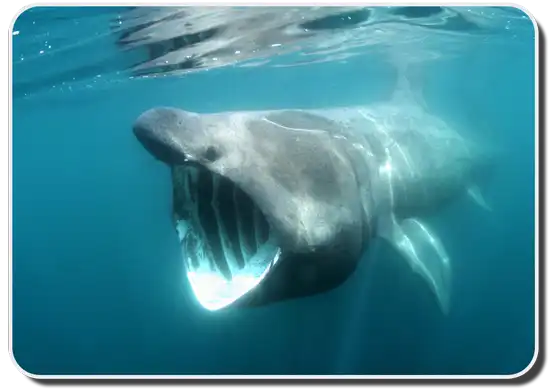For a long time, many people in the scientific community believed that sharks were not highly evolved and that cartilaginous skeletons were a primitive biological trait. However as more fossil records are discovered, scientists realized that cartilaginous skeletons are actually an evolved feature that has given sharks many biological advantages. Cartilaginous skeletons are lightweight, flexible, and help make sharks efficient, stealthy hunters.

The Fossil Record
The main reason why so many scientists believe that sharks were not highly evolved is because cartilaginous skeletons do not leave much of a fossil record. Unlike bone, over a short time cartilage will completely degrade. So most of what we know about prehistoric sharks and shark evolution is from their teeth, which stay long after their skeletons have disappeared. Other information come from their denticles that embed into sentiment which over time leaves a fossilized imprint. Until recently there were only two real fossil records scientists have been able to find The first is a complete fossil of Cladoselache that dates back to 360 million years. The second is a partial fossil of Doliodus that dates back 400 million years. Both of these fossils did nothing to dispute the idea that cartilaginous skeletons were an evolved feature.
The Proof Of Evolutionary Development
However in 2005, paleontologists in Western Australia found a complete fossil that challenged the notions that cartilage skeletons are primitive. The fossil Gogoselachus lynbeazleyae, nicknamed Gogo Shark, contained remnant bone cells in the cartilage. The presence of these cells proved that sharks started as bony fish and evolved the cartilaginous skeleton. So cartilage was actually an adaptation that developed to give sharks distinct advantages over bony fish. This information about sharks proved that sharks are actually highly advanced creatures and not merely a successful primitive fish.
The Benefits Of A Cartilaginous Skeleton
Once scientists realized that cartilaginous skeletons were actually evolved from bone, they start assessing the advantages of cartilage skeletons to understand how they developed over time. Scientists found there were several advantages of cartilage over bone. These advantages are why sharks have remained largely unchanged for over hundreds of millions of years. Sharks are an incredibly successful species because of their cartilaginous skeletons. The benefits of having a cartilaginous skeleton include:
- Weight Reduction: Cartilage is strong and dense, but it is not as heavy as bone. So it reduces the weight of sharks making it easier for them to swim at faster speeds with less energy being expelled. Being lightweight makes them incredibly efficient predators because they can move faster, consume less, and burn less energy when they are swimming. These advantages also help them avoid predators.
- Buoyancy: Cartilage is lightweight and thus much more buoyant than bones. Unlike bony fish, sharks do not need swim bladders to maintain neutral buoyancy. This is because their skeleton is made of cartilage. Since they don’t need to expel extra energy to stay afloat, there is more energy available for propulsion. The added benefit of buoyancy saves energy for their hunting.
- Flexibility: Cartilage is incredibly flexible. Bone skeletons rely on cartilage at the joints so that animals can bend and flex. However an entire skeleton of cartilage makes sharks uniquely flexible. This flexibility helps sharks be better hunters because they can turn and twist quicker when hunting or battling prey.
- Tough Skin: Since cartilage is not as strong as bone, sharks have developed a thick layer of strong skin. This skin helps protect them, acting similarly to an exoskeleton, but without losing flexibility. Thick skin gives them another advantage because it helps protect them from injury while hunting.
- Extendable Jaws: Since their skeletons are made of cartilage they do not need a complex connective levered to attach their jaws to their skeletons. This means that their jaws are much more flexible and can extend outward to grab their prey simply by opening their mouths. This expels less energy plus it gives them the advantage of both grabbing their prey from further away and protecting their heads if they prey fights back.
- Bite Force: Predatory sharks have the strongest bite force of any animal on the planet. This is because of their cartilaginous skeleton. The cartilage allows a shark’s jaw to be more flexible and closely attached to the musculature, so there are less impediments to a shark’s bite. This strong bite force helps sharks kill their prey quicker and will less expelled energy.
Sharks Rely On Different Types Of Cartilage
Considering all of the advantages of cartilage skeletons, there is a clear reason why they would be a beneficial evolutionary adaptation. However, the cartilage itself has also evolved to adapt to the needs of the shark. For example, around the jawline and backbone cartilage is too weak to fully support the shark. So in these areas, sharks have developed calcified cartilage. Calcified cartilage is a cartilage that has been hardened by calcium and is strong like bone, but still very lightweight. So it helps support the areas where bone would be more beneficial without compromising the benefits of cartilage. Furthermore, the skull and snout of a shark is made from a denser form of cartilage to protect the brain and eyes. This also helps the snout absorb more blows during attacks without injury. These adaptations also prove that sharks evolved cartilaginous skeletons for a reason.
So even with a difficult fossil record, the discovery of the Gogo Shark helped prove that cartilage was an evolutionary adaptation developed from bones. With this discovery and the information about sharks that scientists have collected over the years show that cartilage is incredibly efficient evolutionary adaptation that helps them be skilled hunters. Therefore, sharks have remained largely unchanged for all these years not because they are primitive but because their evolutionary development has been so successful.
